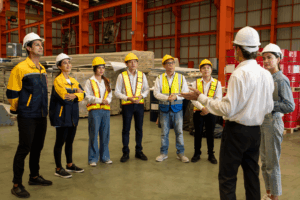
Q&A: What controls need to be in place to reduce welding-related fire hazards?
What controls need to be in place to limit fire hazards associated with welding?
All types of welding generate intense heat that has the potential to start a fire. Combustible materials should be removed from the work area, at least 35 feet (ft) away from the heat source. If combustible materials cannot be feasibly moved at least 35 ft from the heat source, then guards must be used to confine the heat, sparks, and slag and to protect the immovable fire hazards. If these precautions cannot be followed, welding, cutting, or brazing must not be done.
Fire extinguishers
Fire extinguishers must be charged, inspected, and ready for instant use.
Fire watch
A designated fire watch person must stand ready at least 30 minutes after welding or cutting operations if more than a minor fire might develop and if any of the following conditions exist:
- Appreciable combustible material, in building construction or contents, closer than 35 feet to the point of operation.
- Appreciable combustibles are more than 35 feet away but are easily ignited by sparks.
- Wall or floor openings within a 35-foot radius expose combustible material in adjacent areas including concealed spaces in walls or floors.
- Combustible materials are adjacent to the opposite side of metal partitions, walls, ceilings, or roofs and are likely to be ignited by conduction or radiation.
Fire watchers must have a fire extinguisher readily available and be trained in its use. In addition, fire watchers must be familiar with the procedures for sounding an alarm in the event of a fire. Fire watchers will watch for fires in all exposed areas, and if a fire occurs, they will try to extinguish them only when obviously within the capacity of the equipment available, otherwise they will sound the alarm.
Inspection and authorization
A responsible individual or supervisor must inspect the area and designate precautions, preferably by written permit. The supervisor will authorize the start of welding, cutting, or brazing work.
What is EHS Hotline?
Subscribers of EHS Hero get access to our team of in-house subject matter experts. EHS Hotline allows subscribers to submit questions and receive timely, thorough, and plain-language answers from our team of experts—complete with resources and references.
The purpose of EHS Hotline is to help connect workplace employment, safety, and environment questions to the material provided by BLR on its subscriber websites. While the service is defined as providing advice, it is assistance to help bridge the gap between the BLR compliance resources and our client’s workplace issues. It is not a legal opinion or replacement for seeking legal counsel.



